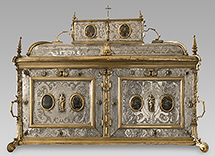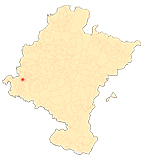Saint Gregory of Ostia
Arqueta de San Gregorio
The first news of the execution of this work dates from November 7, 1601, when in his pastoral visit to Sorlada, the Bishop of Pamplona, Fray Mateo de Burgos, ordered, by means of a mandate of visit, the execution of a chest to contain the remains of San Gregorio. We believe that it is the work of the silversmiths Martín and Agustín de Agorreta, who delivered it on May 9, 1610. It is a rectangular piece supported by four legs formed by twisted leather, and with the fronts framed in the angles by pilasters of plateresque character, to whose edges are attached ribs, which alternate on the front faces of the chest with pilasters of classicist lineage. The articulation of the fronts is made by means of rectangular frames, which inscribe oval frames of painted glass, framing in the center a figure of half a bulk. It has a double body cover, the lower one convex and the upper one prismatic, with oval mirrors separated by hermes on the fronts of the latter. The whole set is topped by a cross, on a modern pedestal, and Herrerian pyramids on balls. It is covered by a rich decoration composed of a mannerist ornamental system of geometric elements, facing C's, flat ribbons, cabochons, pilasters, pyramids, ribs and appliqués of rhinestones. The polychromy of the piece contributes to its visual richness, playing with alternating silver in its color and gilded silver, bronze and brass. Of great interest is also the iconography of the work, with the figures of St. John, St. James, St. Peter and St. Andrew, as well as four unidentified Apostles, to which must be added the images arranged in the reliquary medallions.
BARRAGÁN LANDA, J.J., "Las plagas del campo español y la devoción a San Gregorio Ostiense", in Cuadernos de Etnología y Etnografía en Navarra, n 29, Pamplona, 1978.
CRUZ VALDOVINOS, J.M., "Historia de la platería en la basílica de San Gregorio Ostiense", in Príncipe de Viana, n 163, Pamplona, 1981.
GARCÍA GAINZA, Mª.C. and others, Catalog monumental de Navarra. Merindad de Estella, Volume III**, Pamplona, 1983.
GARCÍA GAINZA, Mª.C., "Arca-relicario de San Gregorio Ostiense de Sorlada", in FERNÁNDEZ GRACIA, R., (Coord.) Pamplona y San Cernín 1611-2011. IV centenary of the city's vow, Pamplona, 2012.
MADRAZO Y KUNTZ, P., Navarra y Logroño, Barcelona, 1886.
MIGUÉLIZ VALCARLOS, I., "Medallones relicarios de origen lombardo en una pieza de orfebrería navarra: el arca relicario de Sorlada", in OADI. Osservatorio per le Arti Decorative in Italia, no. 6, Palermo, 2012.
PASTOR ABAIGAR, V., Fábrica de San Gregorio Ostiense. Basílica y Hospedería, Government of Navarre, Pamplona, 2015.
SALAZAR A. de, Historia de San Gregorio de Piñalva, Obispo de Ostia, Cardenal de la santa Iglesia de Roma, y su bibliotecario y bequest à Latere, Pamplona, 1624.











